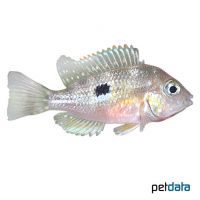Golden Acara (Thorichthys aureus)
| Golden Acara Thorichthys aureus | |
|---|---|
| Name | Golden Acara |
| Name Lat. | Thorichthys aureus |
| Synonym | Heros aureus |
| Family | Cichlids |
| Family lat. | Cichlidae |
| Order | Cichlids |
| Order lat. | Cichliformes |
| Origin | Central America |
| Habitat | Streams, rivers, floodplains |
| Diet | Carnivore |
| pH | 7.0-8.0 |
| Behavior | Semi-aggressive |
| Keeping | Pair, group |
| Care Level | Moderate |
| Reproduction | Substrate spawner |
| Breeding | Simple |
| Life Span | N/A |
| Protection | No |
| Metric Units | |
| Size | 14 cm |
| Temperature | 22-26 °C |
| Hardness | 5-15 °dH |
| Aquarium | ~ 300 l |
| US Units | |
| Size | 5.5" |
| Temperature | 72-79 °F |
| Hardness | 89-267 ppm |
| Aquarium | ~ 80 gal |
Distribution and habitat
Golden cichlids are widely distributed on the Atlantic side of Central America, from Belize (Golden Creek) to Honduras (Motagua River). They live in shallow, slow-moving streams, rivers and oxbows, and in floodplains with sandy-muddy bottoms, fallen leaves, stones and dead wood.
Maintenance
The aquarium should have a robust planting, with many hiding places (stones, roots, caves) and provide sufficient swimming space. A dark substrate covered with some foliage (e.g. sea almond leaves) and subdued light (floating plants) is ideal. Some flat stones, which serve as spawning ground, should not be missing
No ammonia, ammonium and nitrite should be detectable, the nitrate value should not exceed 100 mg/l. To ensure the water quality and oxygen content, a filter and heater adapted to the aquarium size is required, as well as lighting for the species-appropriate day-night rhythm of the animals.
Diet
In the wild they feed mainly on insect larvae and small crustaceans living in the sand. The food supply consists of live, frozen and dry food. For a balanced diet, feed once a day with a sinking, protein-rich dry food for cichlids (flakes, granules, pellets) as well as daphnia, artemia, mysis, mosquito larvae, etc. (live or frozen).
It is recommended to feed small portions several times a day. Only feed as much as will be eaten within a few minutes. A regular and varied diet promotes health and increases resistance.
Behaviour and compatibility
These peaceful, not very assertive fish should be kept in pairs or better in a group of 6-8 animals. Only during the spawning season they behave territorially. However, keeping a group is only recommended in a larger and richly structured tank. They can be socialized well with e.g. larger tetras, swordtails and catfish.
Basically, only compatible fish species with similar demands on water quality and water temperature should be socialized.
Sex dimorphism
Juveniles are difficult to distinguish. Adult males are more colorful and the dorsal and anal fins are filamentously elongated. Females have a dark spot in the dorsal fin at spawning time.
Reproduction and breeding
They are open breeders, both parents perform brood care and defend the territory (parental family). The female usually spawns up to 400 eggs on a well cleaned flat stone, root or other substrate (substrate spawners). After about 3 days, the fry hatch and are then usually placed in a prepared bottom pit until they swim freely after 4-5 days. Often the school of young fish is still guarded by the parents for some time and also led to the feeding places in the aquarium before the brood care ends.
Fry must be fed several times a day with special rearing food (Artemia nauplii). In community tanks breeding is hardly possible, because the fry are easy prey.
Important
They rummage through the substrate in search of food, but hardly damage the plants in the process
In their large distribution area there are several differently colored populations.
The well-being of the fish should be checked regularly. Temperature should be checked daily, pH, hardness and nitrate levels at least fortnightly. Regular partial water changes are recommended, even when contaminant levels have not yet reached the upper limit. Sudden changes in water quality should be avoided. Newly introduced fish must be accustomed slowly to the water in the aquarium.
Further literature can be found in your pet store.
References
Text: petdata; Image: petdata
Source: BMEL (1998): Tierschutzgutachten - Haltung von Zierfischen (Süßwasser); RIEHL & BAENSCH (2004): Aquarien Atlas Bd. 3, Mergus Verlag; ENGELMANN (2005): Zootierhaltung - Tiere in menschlicher Obhut: Fische, Verlag Harri Deutsch
- Gemäß § 21 Abs. 5 Tierschutzgesetz idgF
